What we learned at our first official GV design sprint
Inayaili de León Persson
on 4 April 2017
Tags: Design
Last month the web team ran its first design sprint as outlined in The Sprint Book, by Google Ventures’ Jake Knapp. Some of us had read the book recently and really wanted to give the method a try, following the book to the letter.
In this post I will outline what we’ve learned from our pilot design sprint, what went well, what could have gone better, and what happened during the five sprint days. I won’t go into too much detail about explaining what each step of the design sprint consists of — for that you have the book. If you don’t have that kind of time, but would still like to know what I’m talking about, here’s an 8-minute video that explains the concept:
Before the sprint
One of the first things you need to do when running a design sprint is to agree on a challenge you’d like to tackle. Luckily, we had a big challenge that we wanted to solve: ubuntu.com‘s navigation system.
 ubuntu.com’s different levels of navigation
ubuntu.com’s different levels of navigation
Assigning roles
If you’ve decided to run a design sprint, you’ve also probably decided who will be the Facilitator. If you haven’t, you should, as this person will have work to do before the sprint starts. In our case, I was the Facilitator.
My first Facilitator task was to make sure we knew who was going to be the Decider at our sprint.
We also agreed on who was going to participate, and booked one of our meeting rooms for the whole week plus an extra one for testing on Friday.
My suggestion for anyone running a sprint for the first time is to also name an Assistant. There is so much work to do before and during the sprint, that it will make the Facilitator’s life a lot easier. Even though we didn’t officially name anyone, Greg was effectively helping to plan the sprint too.
Evangelising the sprint
In the week that preceded the sprint, I had a few conversations with other team members who told me the sprint sounded really great and they were going to ‘pop in’ whenever they could throughout the week. I had to explain that, sadly, this wasn’t going to be possible.
If you need to do the same, explain why it’s important that the participants commit to the entire week, focusing on the importance of continuity and of accumulated knowledge that the sprint’s team will gather throughout the week. Similarly, be pleasant but firm when participants tell you they will have to ‘pop out’ throughout the week to attend to other matters — only the Decider should be allowed to do this, and even so, there should be a deputy Decider in the room at all times.
Logistics
Before the sprint, you also need to make sure that you have all the supplies you need. I tried as much as possible to follow the suggestions for materials outlined in the book, and I even got a Time Timer. In retrospect, it would have been fine for the Facilitator to just keep time on a phone, or a less expensive gadget if you really want to be strict with the no-phones-in-the-room policy.
Even though the book says you should start recruiting participants for the Friday testing during the sprint, we started a week before that. Greg took over that side of the preparation, sending prompts on social media and mailing lists for people to sign up. When participants didn’t materialise in this manner, Greg sent a call for participants to the mailing list of the office building we work at, which worked wonders for us.
Know your stuff
Assuming you have read the book before your sprint, if it’s your first sprint, I recommend re-reading the chapter for the following day the evening before, and take notes.
I printed out the checklists provided in the book’s website and wrote down my notes for the following day, so everything would be in one place.
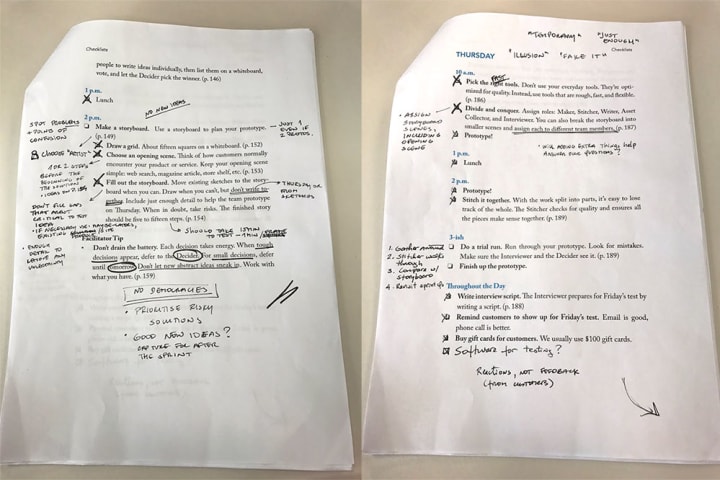 Facilitator checklists with handwritten notes
Facilitator checklists with handwritten notes
I also watched the official video for the day (which you can get emailed to you by the Sprint Bot the evening before), and read all the comments in the Q&A discussions linked to from the emails. These questions and comments from other people who have run sprints was incredibly useful throughout the week.
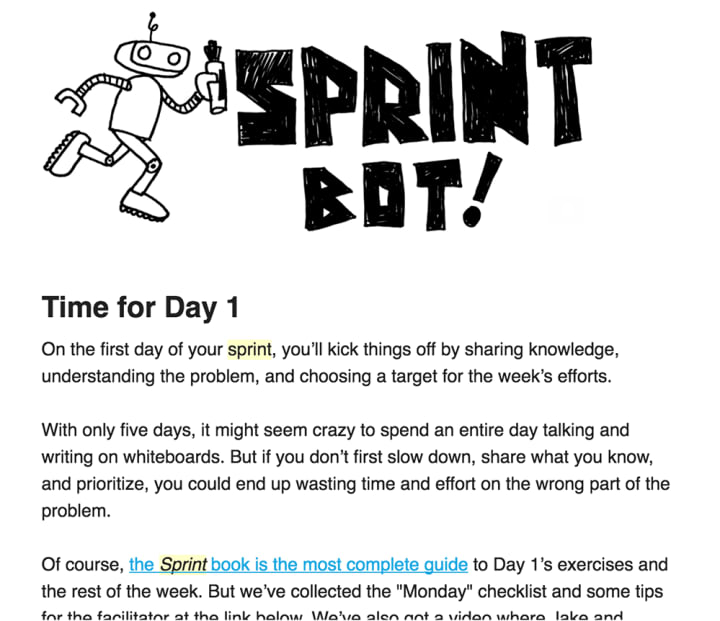 Sprint Bot email for the first day of the sprint
Sprint Bot email for the first day of the sprint
Does this sound like a lot of work? It was. I think if/when we do another sprint the time spent preparing will probably be reduced by at least 50%. The uncertainty of doing something as involved as this for the first time made it more stressful than preparing for a normal workshop, but it’s important to spend the time doing it so that things run smoothly during the sprint week.
Day 1
The morning of the sprint I got in with plenty of time to spare to set up the room for the kick-off at 10am.
I bought lots of healthy snacks (which were promptly frowned on by the team, who were hoping for sweater treats); brought a jug of water and cups, and all the supplies to the room; cleared the whiteboards; and set up the chairs.
What follows are some of the outcomes, questions and other observations from our five days.
Morning
In the morning of day 1 you define a long term goal for your project, list the ways in which the project could fail in question format, and draw a flowchart, or map, of how customers interact with your product.
- Starting the map was a little bit tricky as it wasn’t clear how the map should look when there are more than one type of customer who might have different outcomes
- In the book there are no examples with more than one type of customer, which meant we had to read and re-read that part of the book until we decided how to proceed as we have several customer types to cater for
- Moments like these can take the confidence in the process away from the team, that’s why it’s important for the Facilitator to read everything carefully more than once, and ideally for him or her not to be the only person to do so
- We did the morning exercises much faster than prescribed, but the same didn’t happen in the afternoon!
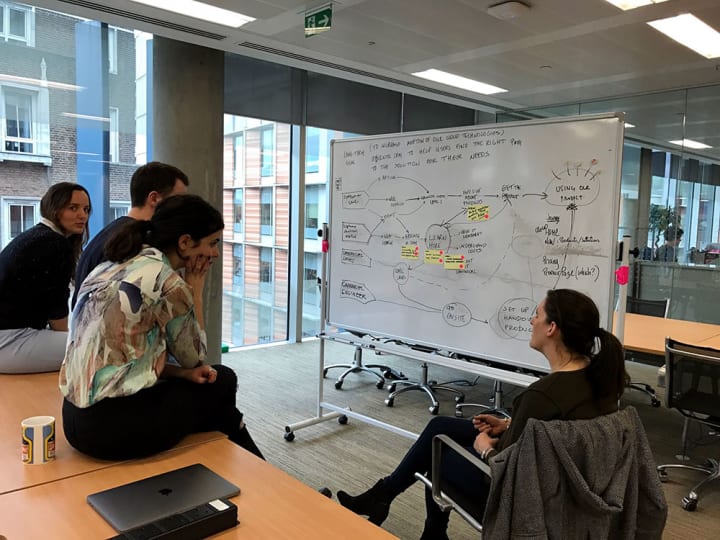 Discussing the target for the sprint
Discussing the target for the sprint
Afternoon
In the afternoon experts from the sprint and guests come into the room and you ask them lots of questions about your product and how things work. Throughout the interviews the team is taking notes in the “How Might We” format (for example, “How might we reduce the amount of copy?”). By the end of the interviews, you group the notes into themes, vote on the ones you find most useful or interesting, move the most voted notes onto their right place within your customer map and pick a target in the map as the focus for the rest of the sprint.
- If you have time, explain “How Might We” notes work before the lunch break, so you save that time for interviews in the afternoon
- Each expert interview should last for about 15-30 minutes, which didn’t fee like long enough to get all the valuable knowledge from our experts — we had to interrupt them somewhat abruptly to make sure the interviews didn’t run over. Next time it might be easier to have a list of questions we want to cover before the interviews start
- Choreographing the expert interviews was a bit tricky as we weren’t sure how long each would take. If possible, tell people you’ll call them a couple of minutes before you need them rather than set a fixed time — we had to send people back a few times because we weren’t yet finished asking all the question to the previous person!
- It took us a little longer than expected to organise the notes, but in the end, the most voted notes did cluster around the key section of the map, as predicted in the book!
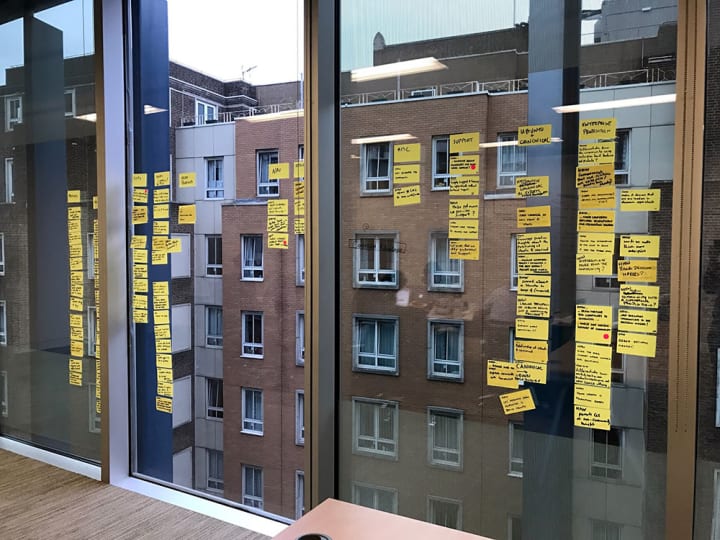 Some of the How Might We notes on the wall after the expert interviews
Some of the How Might We notes on the wall after the expert interviews
Other thoughts on day 1
- Sprint participants might cancel at the last minute. If this happens, ask yourself if they could still appear as experts on Monday afternoon? If not, it’s probably better to write them off the sprint completely
- There was a lot of checking the book as the day went by, to confirm we were doing the right thing
- We wondered if this comes up in design sprints frequently: what if the problem you set out to solve pre-sprint doesn’t match the target area of the map at the end of day 1? In our case, we had planned to focus on navigation but the target area was focused on how users learn more about the products/services we offer
A full day of thinking about the problem and mapping it doesn’t come naturally, but it was certainly useful. We conduct frequent user research and usability testing, and are used to watching interviews and analysing findings, nevertheless the expert interviews and listening to different perspectives from within the company was very interesting and gave us a different type of insight that we could build upon during the sprint.
Day 2
By the start of day 2, it felt like we had been in the sprint for a lot longer than just one day — we had accomplished a lot on Monday!
Morning
The morning of day 2 is spent doing “Lightning Demos” after a quick 20-minute research. These can be anything that might be interesting, from competitor products to previous internal attempts at solving the sprint challenge. Before lunch, the team decides who will sketch what in the afternoon: will everyone sketch the same thing or different parts of the map.
- We thought the “Lightning Demos” was a great way to do demos — it was fast and captured the most important thing quickly
- Deciding who would sketch what wasn’t as straightforward as we might have thought. We decided that everyone should do a journey through our cloud offerings so we’d get different ideas on Wednesday, knowing there was the risk of not everything being covered in the sketches
- Before we started sketching, we made a list of sections/pages that should be covered in the storyboards
- As on day 1, the morning exercises were done faster than prescribed, we were finished by 12:30 with a 30 minute break from 11-11:30
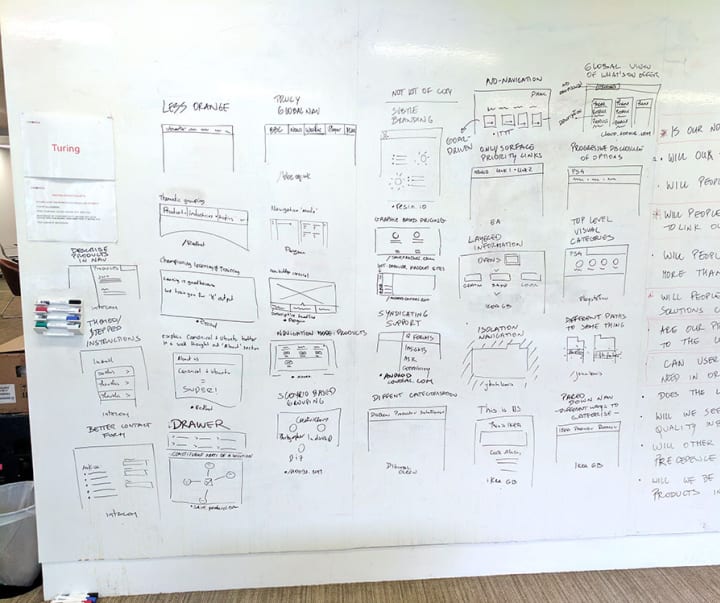 Our sketches from the lightning demos
Our sketches from the lightning demos
Afternoon
In the afternoon, you take a few minutes to walk around the sprint room and take down notes of anything that might be useful for the sketching. You then sketch, starting with quick ideas and moving onto a more detailed sketch. You don’t look at the final sketches until Wednesday morning.
- We spent the first few minutes of the afternoon looking at the current list of participants for the Friday testing to decide which products to focus on in our sketches, as our options were many
- We had a little bit of trouble with the “Crazy 8s” exercise, where you’re supposed to sketch 8 variations of one idea in 8 minutes. It wasn’t clear what we had to do so we re-read that part a few times. This is probably the point of the exercise: to remove you from your comfort zone, make you think of alternative solutions and get your creative muscles warmed up
- We had to look at the examples of detailed sketches in the book to have a better idea of what was expected from our sketches
- It took us a while to get started sketching but after a few minutes everyone seemed to be confidently and quietly sketching away
- With complicated product offerings there’s the instinct to want to have access to devices to check product names, features, etc – I assumed this was not allowed but some people were sneakily checking their laptops!
- Naming your sketch wasn’t as easy as it sounded
- Contrary to what we expected, the afternoon sketching exercises took longer than the morning’s, at 5pm some people were still sketching
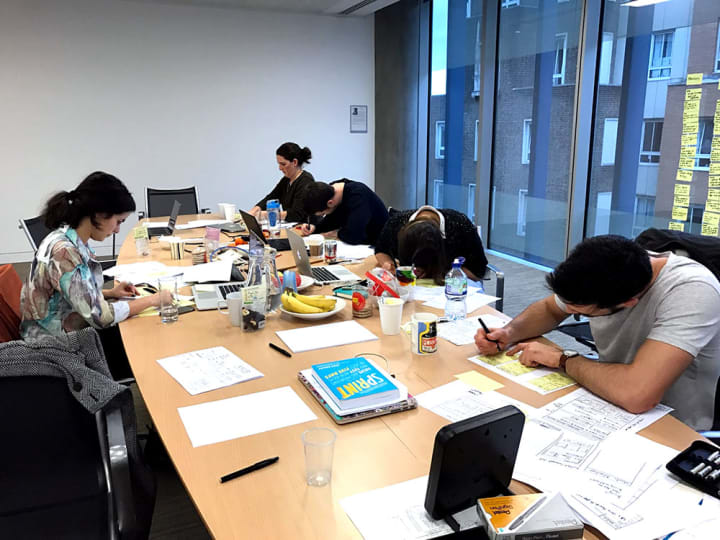 Everyone sketching in silence on Tuesday afternoon
Everyone sketching in silence on Tuesday afternoon
Tuesday was lots of fun. Starting the day with the demos, without much discussion on the validity of the ideas, creates a positive mood in the team. Sketching in a very structured manner removes some of the fear of the blank page, as you build up from loose ideas to a very well-defined sketch. The silent sketching was also great as it meant we had some quiet time to pause and think a solution through, giving the people who tend to be more quiet an opportunity to have their ideas heard on par with everyone else.
Day 3
No-one had seen the sketches done on Tuesday, so the build-up to the unveiling on day 3 was more exciting than for the usual design review!
Morning
On the Wednesday morning, you decide which sketch (or sketches) you will prototype. You stick the sketches on the wall and review them in silence, discuss each sketch briefly and each person votes on their favourite. After this, the Decider casts three votes, which can follow or not the votes of the rest of the team. Whatever the Decider votes on will be prototyped. Before lunch, you decide whether you will need to create one or more prototypes, depending on whether the Decider’s (or Deciders’) votes fit together or not.
- We had 6 sketches to review
- Although the book wasn’t clear as to when the guest Decider should participate, we invited ours from 10am to 11.30am as it seemed that he should participate in the entire morning review process — this worked out well
- During the speed critique people started debating the validity or feasibility of solutions, which was expected but meant some work for the Facilitator to steer the conversation back on track
- The morning exercises put everyone in a positive mood, it was an interesting way to review and select ideas
- Narrating the sketches was harder than what might seem at first, and narrating your own sketch isn’t much easier either!
- It was interesting to see that many of the sketches included similar solutions — there were definite patterns that emerged
- Even though I emphasised that the book recommends more than one prototype, the team wasn’t keen on it and the focus of the pre-lunch discussion was mostly on how to merge all the voted solutions into one prototype
- As for all other days, and because we decided for an all-in-one prototype, we finished the morning exercises by noon
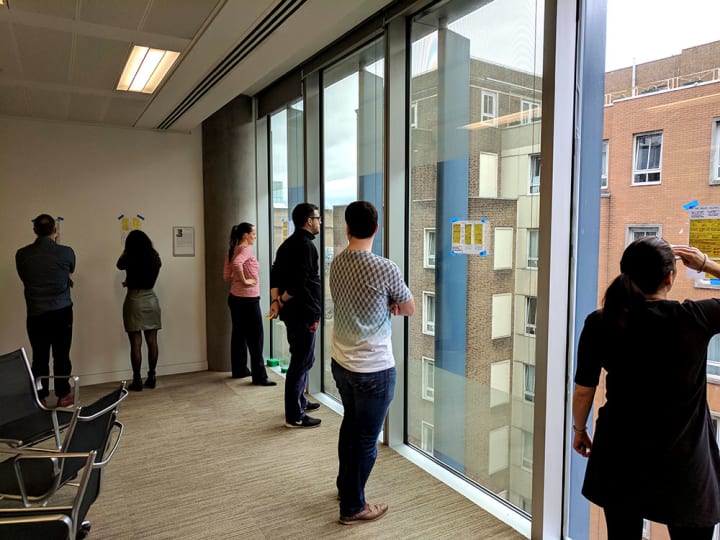 The team reviewing the sketches in silence on Wednesday morning
The team reviewing the sketches in silence on Wednesday morning
Afternoon
In the afternoon of day 3, you sketch a storyboard of the prototype together, starting one or two steps before the customer encounters your prototype. You should move the existing sketches into the frames of the storyboard when possible, and add only enough detail that will make it easy to build the prototype the following day.
- Using masking tape was easier than drawing lines for the storyboard frames
- It was too easy to come up with new ideas while we were drawing the storyboard and it was tricky to tell people that we couldn’t change the plan at this point
- It was hard to decide the level of detail we needed to discuss and add to the storyboard. We finished the first iteration of the storyboard a few minutes before 3pm. Our first instinct was to start making more detailed wireframes with the remaining time, but we decided to take a break for coffee and come back to see where we needed more detail in the storyboard instead
- It was useful to keep asking the team what else we needed to define as we drew the storyboard before we started building the prototype the following day
- Because we read out the different roles in preparation for Thursday, we ended up assigning roles straight away
 Discussing what to add to our storyboard
Discussing what to add to our storyboard
Other thoughts on day 3
- One sprint participant couldn’t attend on Tuesday, but was back on Wednesday, which wasn’t ideal but didn’t impact negatively
- While setting up for the third day, I wasn’t sure if the ideas from the “Lightning Demos” could be erased from the whiteboard, so I took a photo of them and erased it as, even with the luxury of massive whiteboards, we wouldn’t have had space for the storyboard later on!
By the end of Wednesday we were past the halfway mark of the sprint, and the excitement in anticipation for the Friday tests was palpable. We had some time left before the clock hit 5 and wondered if we should start building the prototype straight away, but decided against it — we needed a good night’s sleep to be ready for day 4.
Day 4
Thursday is all about prototyping. You need to choose which tools you will use, prioritising speed over perfection, and you also need to assign different roles for the team so everyone knows what they need to do throughout the day. The interviewer should write the interview script for Friday’s tests.
- For the prototype building day, we assigned: two writers, one interviewer, one stitcher, two makers and one asset collector
- We decided to build the pages we needed with HTML and CSS (instead of using a tool like Keynote or InVision) as we could build upon our existing CSS framework
- Early in the afternoon we were on track, but we were soon delayed by a wifi outage which lasted for almost 1,5 hours
- It’s important to keep communication flowing throughout the day to make sure all the assets and content that are needed are created or collected in time for the stitcher to start stitching
- We were finished by 7pm — if you don’t count the wifi outage, we probably would have been finished by 6pm. The extra hour could have been curtailed if there had been just a little bit more detail in the storyboard page wireframes and in the content delivered to the stitcher, and fewer last minute tiny changes, but all-in-all we did pretty well!
 Joana and Greg working on the prototype
Joana and Greg working on the prototype
Other thoughts on day 4
- We had our sprint in our office, so it would have been possible for us to ask for help from people outside of the sprint, but we didn’t know whether this was “allowed”
- We could have assigned more work to the asset collector: the makers and the stitcher were looking for assets themselves as they created the different components and pages rather than delegating the search to the asset collector, which is how we normally work
- The makers were finished with their tasks more quickly than expected — not having to go through multiple rounds of reviews that sometimes can take weeks makes things much faster!
By the end of Thursday there was no denying we were tired, but happy about what we had accomplished in such a small amount of time: we had a fully working prototype and five participants lined up for Friday testing. We couldn’t wait for the next day!
Day 5
We were all really excited about the Friday testing. We managed to confirm all five participants for the day, and had an excellent interviewer and solid prototype. As the Facilitator, I was also happy to have a day where I didn’t have a lot to do, for a change!
Thoughts and notes on day 5
On Friday, you test your prototype with five users, taking notes throughout. At the end of the day, you identify patterns within the notes and based on these you decide which should be the next steps for your project.
- We’re lucky to work in a building with lots of companies who employ our target audience, but we wonder how difficult it would have been to find and book the right participants within just 4 days if we needed different types of users or were based somewhere else
- We filled up an entire whiteboard with notes from the first interview and had to go get extra boards during the break
- Throughout the day, we removed duplicate notes from the boards to make them easier to scan
- Some participants don’t talk a lot naturally and need a lot of constant reminding to think out loud
- We had the benefit of having an excellent researcher in our team who already knows and does everything the book recommends doing. It might have been harder for someone with less research experience to make sure the interviews were unbiased and ran smoothly
- At the end of the interviews, after listing the patterns we found, we weren’t sure whether we could/should do more thorough analysis of the testing later or if we should chuck the post-it notes in the bin and move on
- Our end-of-sprint decision was to have a workshop the following week where we’d plan a roadmap based on the findings — could this be considered “cheating” as we’re only delaying making a decision?
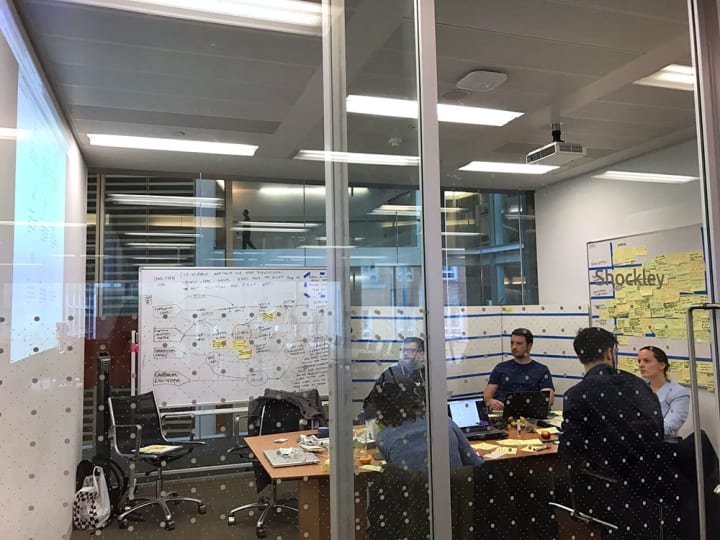 The team observing the interviews on Friday
The team observing the interviews on Friday
 A wall of interview notes
A wall of interview notes
The Sprint Book notes that you can have one of two results at the end of your sprint: an efficient failure, or a flawed success. If your prototype doesn’t go down well with the participants, your team has only spent 5 days working on it, rather than weeks or potentially months — you’ve failed efficiently. And if the prototype receives positive feedback from participants, most likely there will still be areas that can be improved and retested — you’ve succeeded imperfectly.
At the end of Friday we all agreed that we our prototype was a flawed success: there were things we tested that we’d had never think to try before and that received great feedback, but some aspects certainly needed a lot more work to get right. An excellent conclusion to 5 intense days of work!
Final words
Despite the hard work involved in planning and getting the logistics right, running the web team’s trial design sprint was fun.
The web team is small and stretched over many websites and products. We really wanted to test this approach so we could propose it to the other teams we work with as an efficient way to collaborate at key points in our release schedules.
We certainly achieved this goal. The people who participated directly in the sprint learned a great deal during the five days. Those in the web team who didn’t participate were impressed with what was achieved in one week and welcoming of the changes it initiated. And the teams we work with seem eager to try the process out in their teams, now that they’ve seen what kind of results can be produced in such a short time.
How about you? Have you run a design sprint? Do you have any advice for us before we do it again? Leave your thoughts in the comments section.
Talk to us today
Interested in running Ubuntu in your organisation?
